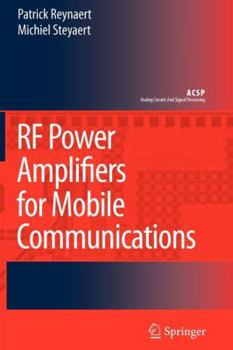RF Power Amplifiers for Mobile Communications
Preface. 1. INTRODUCTION. 1.1 Wireless Communication. 1.2 CMOS Technology and Scaling. 1.2.1 Moore's Law. 1.2.2 RF-CMOS: Moore meets Marconi. 1.3 The ResearchWork. 1.4 Outline of the Work. 2. MOBILE COMMUNICATION SYSTEMS AND POWER AMPLIFICATION. 2.1 Introduction. 2.2 Mobile Communication Systems. 2.2.1 Modulated Bandpass Signals. 2.2.2 Digital Modulation. 2.2.3 Probability Density Function of the Envelope Signal. 2.3 Some Aspects of Power Amplification. 2.3.1 Output Power. 2.3.2 Peak Output Power and Crest Factor. 2.3.3 Input Power and Power Gain. 2.3.4 Efficiency. 2.3.5 Efficiency and Modulated Signals. 2.3.6 Power Control. 2.3.7 Linearity. 2.3.8 Inductors, Capacitors and Quality Factor. 2.4 Power Amplifier Classification. 2.4.1 Class A. 2.4.2 Reduced Conduction Angle: Class AB, B and C. 2.4.3 Saturated Class A. 2.4.4 Harmonic Tuning for Improved Efficiency: Class F. 2.4.5 Switching Amplifiers. 2.4.6 Class D. 2.4.7 Class E. 2.4.8 Reliability. 2.5 Efficiency and Linearity. 2.5.1 Efficiency Improvement of Linear Amplifiers. 2.5.2 Linearization of Nonlinear Amplifiers. 2.6 Conclusion. 3. ANALYSIS AND DESIGN OF THE CLASS E POWER AMPLIFIER IN CMOS. 3.1 Introduction. 3.2 A Theoretical Study of the Class E Amplifier. 3.2.1 The Class E Requirements. 3.2.2 Existing Methods to Solve the Class E Equations. 3.2.3 A State-Space Model of the Class E Power Amplifier. 3.2.4 Limitations of the State-Space Approach. 3.3 Design of the Class E Amplifier in CMOS. 3.3.1 Design of the Load Resistor. 3.3.2 Design of the DC-feed Inductance. 3.3.3 Design of the nMOS switch. 3.3.4 Technology Scaling. 3.3.5 Device Stacking. 3.3.6 Increasing the Operating Frequency. 3.3.7 Deviation from Class E: Class BE. 3.4 CMOS Layout Aspects. 3.4.1 Integrated Inductors. 3.4.2 Decoupling and Bondwires. 3.5 Conclusion. 4. IMPEDANCE TRANSFORMATION AND POWER COMBINATION. 4.1 Introduction.4.2 L-match Impedance Transformation. 4.2.1 Basic Equations. 4.2.2 Inductor Loss and Efficiency. 4.3 Power Combination. 4.3.1 Basic Equations. 4.3.2 Inductor Loss and Efficiency. 4.3.3 Multi Section Lattice-Type LC Balun. 4.3.4 Power Control. 4.3.5 Multi Section LC Balun with Non-Identical Sections. 4.3.6 Merging the Class E Amplifier and the LC Balun. 4.4 Conclusion. 5. POLAR MODULATION. 5.1 Introduction. 5.2 The Polar Modulation Architecture. 5.2.1 Basic Equations. 5.2.2 Envelope Elimination and Restoration. 5.2.3 Influence of the Driver Stages on the Overall Efficiency. 5.2.4 Implementation of the Amplitude Modulator. 5.3 Distortion in a Polar Modulated Power Amplifier. 5.3.1 Nonlinear Polar Modulated Power Amplifier Models. 5.3.2 Feedforward. 5.3.3 Nonlinear on-resistance. 5.3.4 Nonlinear drain-bulk junction capacitance. 5.3.5 Differential Delay. 5.3.6 Envelope Filtering. 5.3.7 Injection of the Phase Signal. 5.3.8 Linearity Improvement Techniques. 5.4 Power Combination and Polar Modulation. 5.5 Full Digital Linearization. 5.5.1 A single-bit RF D-to-A. 5.5.2 The Lattice-type LC balun as a multi-bit RF D-to-A. 5.6 Conclusion. 6. A CMOS POWER AMPLIFIER FOR GSM-EDGE. 6.1 Introduction. 6.2 The EDGE System. 6.2.1 Enhanced Datarates for GSM Evolution. 6.2.2 Generation of the EDGE Signal. 6.2.3 EDGE Transmitter Linearity Requirements. 6.2.4 EDGE Transmitter Output Power Requirements. 6.3 A Polar Modulated Power Amplifier for EDGE. 6.3.1 Architecture. 6.3.2 Distortion. 6.4 Circuit Implementation. 6.4.1 Design of the RF amplifier. 6.4.2 Design of the Linear Amplitude Modulator. 6.4.3 Layout Aspects. 6.5 Measurements. 6.5.1 Measurement Setup. 6.5.2 Constant Envelope Measurements. 6.5.3 AM-AM and AM-PM Distortion Measurement. 6.5.4 EDGE Measurements. 6.5.5 16-QAM Modulation and Two-Tone Test. 6.6 Architectural Improvements. 6.7 Comparison with Other EDGE Solutions. 6.8 Conclusion. 7. A CMOS POWER AMPLIFIER
Format:Paperback
Language:English
ISBN:9048172861
ISBN13:9789048172863
Release Date:November 2010
Publisher:Springer
Length:250 Pages
Weight:0.82 lbs.
Dimensions:0.6" x 6.1" x 9.2"
Customer Reviews
0 rating





